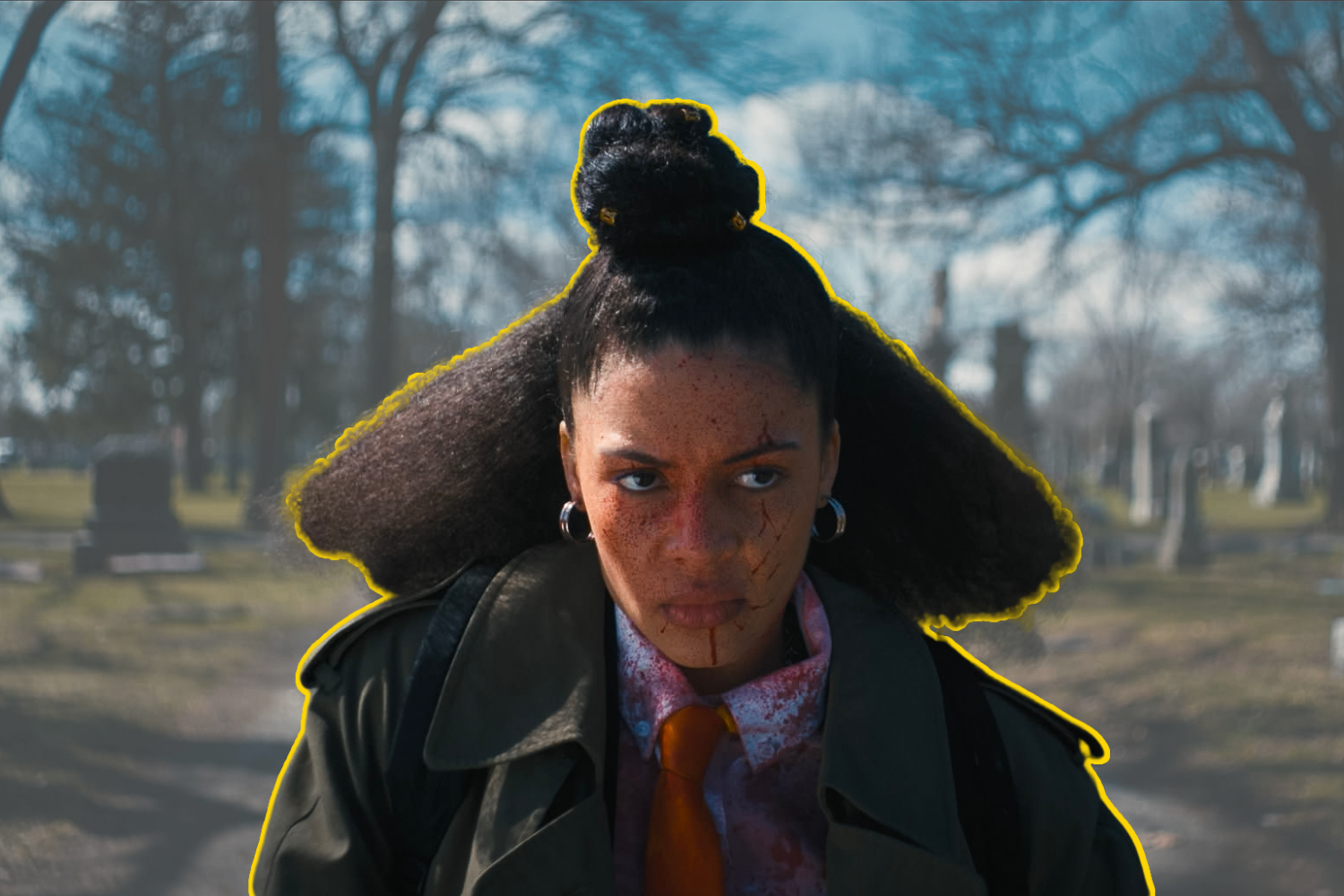Uterus Horror
In ‘Species,’ Biological Clocks Run Amok
November 23rd, 2021 | By Molly Henery

In a genre typically considered “for the guys,” it’s time to give a nod to the ladies. Uterus Horror is a subgenre of horror films that focuses on the uniquely female experience of puberty and the act of coming into your sexuality, using horror elements to emphasize and/or act as a metaphor for that experience. These films are often ignored in theaters but quickly develop cult followings. Columnist Molly Henery, who named and defined the subgenre, tackles a new film each month and analyzes how it fits into this bloody new corner of horror.
Looking back at the different types of Uterus Horror covered in this column, we’ve examined everything from werewolves to succubae, deadly dreams to cannibalism. For November, we’re going to pivot to something a little different. This month not only marks the first sci-fi Uterus Horror entry, but also the first that presents a negative depiction of the genre. That’s right, I’m talking about Species.
Written by Dennis Feldman and directed by Roger Donaldson, Species is a 1995 sci-fi/horror mashup. In the film, scientists send a map of human DNA out into space, hoping to reach anything that might be listening. Years later, they get a response in the form of genetic mapping that combines human and alien DNA. Scientists set out to bring the hybrid to life, resulting in a human-looking girl named Sil (played by a very young Michelle Williams).
When we meet Sil, she appears to be about 11 or 12, right at the age most girls experience puberty. The head of this scientific study, Xavier Fitch (Ben Kingsley), fearing what will happen when Sil reaches full maturity, orders her termination. Yet Sil has other plans. She escapes the facility and catches a ride on a passing train. Fitch knows Sil must be located with haste, so he brings together a team to track and kill the escapee. That team consists of molecular biologist Dr. Laura Baker (Marg Helgenberger), empath Dan Smithson (Forest Whitaker), anthropologist Dr. Stephen Arden (Alfred Molina), and mercenary Preston Lennox (Michael Madsen).
While on the train, Sil becomes ravenous, her metabolism telling her to eat as much as possible as she prepares for a big change. Her alien DNA puts her into a sort of chrysalis. The process is clearly painful as Sil cries out, tentacle-like appendages sprouting from her face to form her cocoon. Much like actual puberty, the filmmakers make a point of depitcing this process as painful, violent, and gruesome. Just a few hours later, Sil emerges from her chrysalis a full-grown woman (now played by Natasha Henstridge). Sil’s emergence from her cocoon seems to mimic birth, the cocoon itself looking reminiscent of a vagina. Appearing to be about 21 years old, Sil has reached full sexual maturity and now has only one thing on her mind; to find a mate and reproduce.
The audience gets a bit of interesting imagery and symbolism with Sil’s chrysalis birth, but that’s not all. The first stop Sil makes after leaving the train is to a dress shop where she buys what looks like a wedding dress. There is an obvious correlation between her newfound maturity and being ready to marry, or in Sil’s case, simply to reproduce. As she walks the streets of LA, Sil is shown looking at pregnant women’s bellies and young children, indicating how deeply ingrained her need to reproduce really is. After getting settled at a hotel, the first thing Sil does is go to the front desk and ask, “Where’s a good place to find a man?”
The rest of the film consists of the team trying to find Sil before she can reproduce. The act could result in deadly consequences with how quickly she reached adulthood, especially if she were to have a boy. At one point Laura finds what appears to be blood on the toilet in Sil’s hotel room and she mentions that if Sil can menstruate, then she can reproduce. Luckily for them, Sil has some trouble finding a mate. Unluckily for everyone around her, Sil is quick to kill when her efforts are thwarted.
At a nightclub, Sil meets a potential mate, but another, more sexually aggressive woman is able to steal him away. Sil kills the woman in the club bathroom before using similarly aggressive tactics to catch the attention of another man. They leave the club, but Sil ends up refusing to sleep with him because, as we later learn, she can sense he is diabetic, so her alien side sees him as a bad partner. The man doesn’t seem keen on taking no for an answer, so Sil kills him as well. Later, after being hit by a car, Sil seems to find a perfect mate in the man who takes her to the hospital, but the team interrupts her seduction and she kills him as well. It isn’t until after she fakes her own death, convincing the team to let their guard down, that Sil finally has intercourse with Stephen. She immediately gets pregnant and, once Stephen realizes who she is and what’s happened, she kills him as well.
Sil escapes into the sewers, taking on her alien form as her pregnancy grows, so Fitch, Laura, Dan, and Lennox act fast to destroy her. Again, showing the horrors of being a woman, even if only half human, Sil’s delivery is portrayed as quite violent and painful for her. She delivers a healthy baby alien boy, who the audience first sees as a toddler only moments after his birth. Then the team traps and kills them both in a fiery death.
What is especially interesting about Species is how it shows a woman’s development from child to sexually mature adult on an accelerated timetable. What realistically takes years is only a matter of days with the addition of alien DNA. Sil reached roughly the age of 12 in a matter of three months. Her jump from that age to full sexual maturity only took hours, as did her pregnancy. An accelerated biological clock is anxiety-inducing, especially when you consider how young many women are when they’re first biologically able to reproduce, and the signals the body sends to trick the mind into thinking that is what a woman should want. It’s the most basic, animalistic instinct.
Unfortunately, the animalistic side portrayed in Species is also part of the problem. The way Sil is shown throughout the film greatly dehumanizes her. Is she only half human, the other half being alien? Yes, of course. But that seems to be an excuse to strip the character down to the most basic traits of women and their biology. It is an excuse to watch the horrors she experiences and be okay with it, while also allowing for Sil to be looked at as a sex symbol. Fitch even says he chose to make the human/alien DNA female because he thought that would make the subject more “docile” and “easy to control.” Obviously, that didn’t work out so well for him (Sil gives him a gruesome death), but it affirms the age-old idea that women are the “gentler sex.” It also makes Sil more disposable, as illustrated by Fitch’s desire to kill her before she’d matured and then creating an entire team to hunt her down.
Species is a unique work of Uterus Horror filmmaking. It has many issues, including the way women are portrayed. The film effectively delivers a story that shows the grizzly changes a woman goes through, only at a greatly accelerated rate, which increases the horror of it all. The problem is that women, and more specifically Sil, are shown as nothing more than breeding machines with a singular goal of reproducing. Based on how women are portrayed in Species, it seems quite clear it is a Uterus Horror film made with male viewers in mind rather than women. Yet there is something still quite entertaining about it. It’s fun to watch the same way exploitation films from the ‘60s and ‘70s are fun to watch. Species is far from the best Uterus Horror film out there, and it honestly has some potentially harmful portrayals of women and womanhood, but it’s a film that stays with you.
Visit our Editorials page for more articles like this. Ready to support more original horror criticism? Join the Certified Forgotten Patreon community today.



